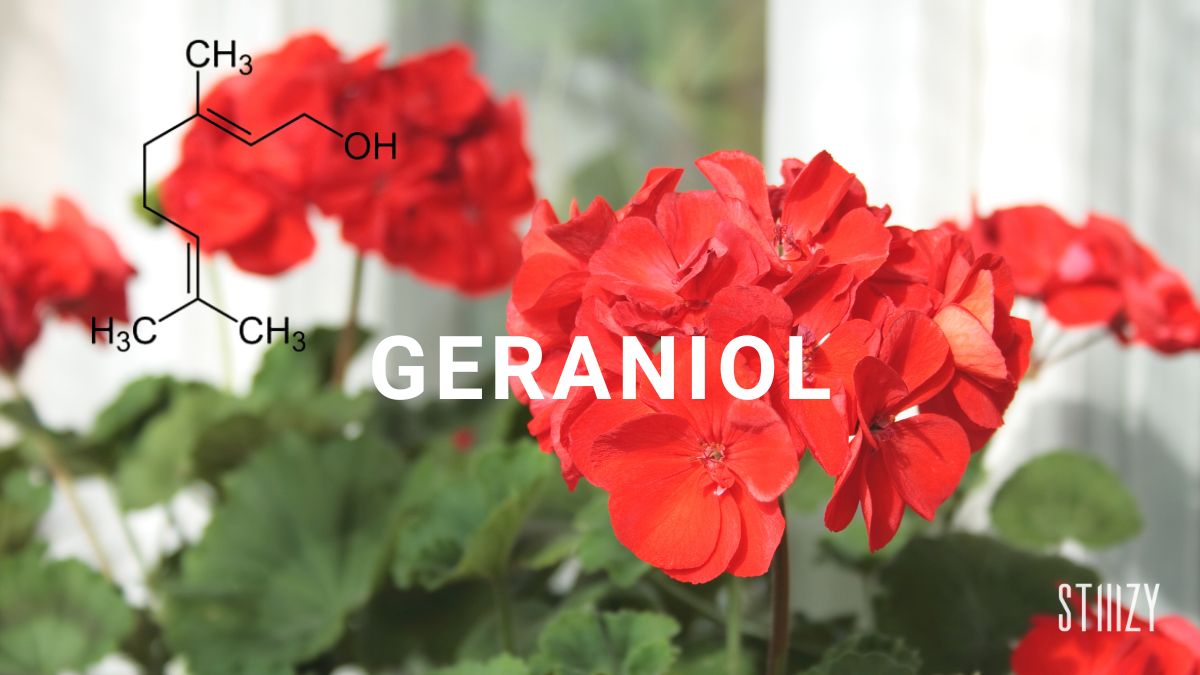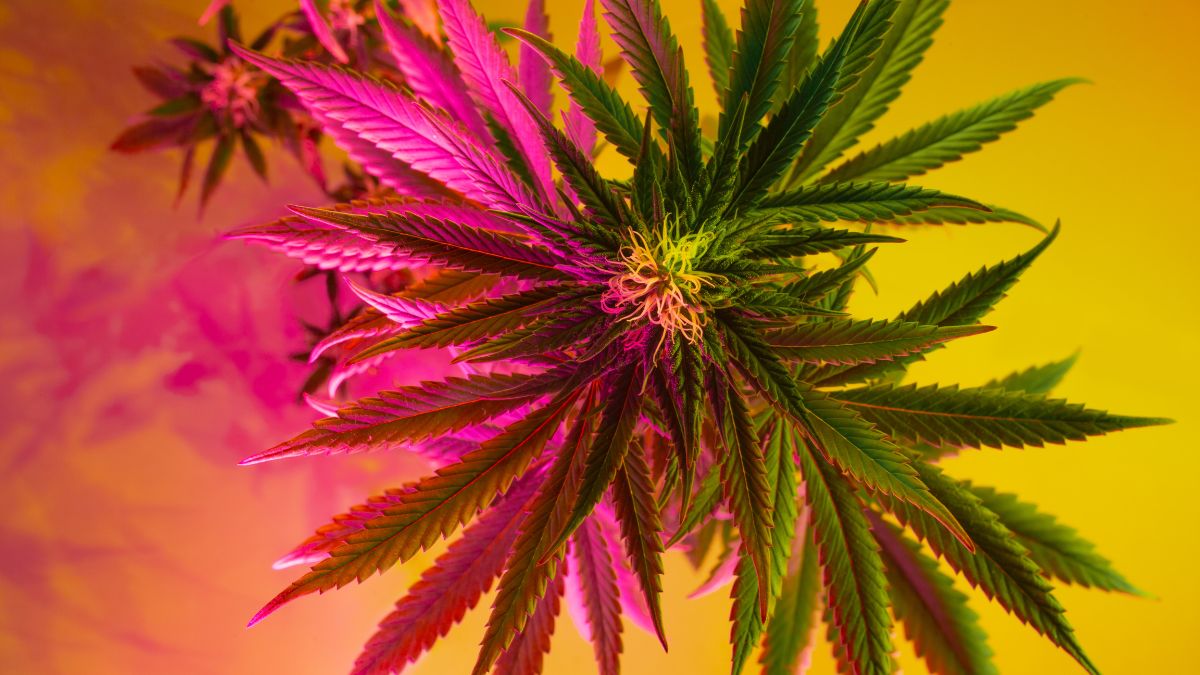Geraniol: Cannabis Terpene Guide

Imagine a world where a single compound could enhance the aroma and flavor of your favorite products, contribute to your well-being, and be safe to use. Welcome to the aromatic world of geraniol terpene! This versatile terpene not only imparts a delightful scent to various plants but also offers a multitude of potential health benefits. Uncover the essence, aroma, and sources of geraniol and its applications in cannabis, everyday products, and healthcare..
Exploring the Essence of Geraniol Terpene
Geraniol terpenes, a naturally occurring terpene, are present in the essential oils of several aromatic plant species such as cannabis, roses, geraniums, citronella, and palmarosa. Their unique sweet, floral scent has made them a popular component in plant-derived essential oils, employed in various products ranging from food additives to perfumes, fragrances, candles, and cleaning products. Despite being a lesser-known terpene, their potential therapeutic benefits have caught the attention of researchers and consumers alike.
Apart from its pleasant aroma and potential health benefits, geraniol also plays a significant role in the life of honey bees. These industrious insects use geraniol to mark nectar-bearing flowers and the entrance to their hives. This fascinating compound’s versatility doesn’t stop there, as it has been recognized as generally safe for human consumption by the FDA, making geraniol a valuable and non-toxic ingredient in various products.
The Aromatic Profile: Geraniol's Signature Scent
The captivating aroma of geraniol is at the core of its allure. Characterized by a sweet, floral scent with some citrus fruit undertones, geraniol imparts a delightful fragrance to various perfumes, fragrances, and even cannabis strains. Its unique olfactory profile is attributed to its chemical formula C10H18O, which is the primary component of citronella oil, rose oil, and palmarosa oil, as well as being found in citrus peel.
Thanks to its unmistakable scent, geraniol has secured a prominent role in numerous products:
-
Perfumes and fragrances, such as Yardley’s monothematic Heritage Collection and those inspired by English flowers
-
Food additives, especially in pastries
-
Cannabis products
From the fragrance industry to the culinary world, geraniol’s signature scent has found a place in countless products we use and enjoy daily.
Geraniol in Nature: Sources and Secretions
Nature’s diverse tapestry has provided us with a myriad of organic compounds., and geraniol is no exception. This naturally occurring terpene can be found in an array of plants, such as:
-
Geraniums
-
Roses
-
Citronella
-
Lemons
Even the bacteria E. coli produces geraniol, one of the organic compounds, as an essential oil, showcasing its ubiquity in nature.

Beyond its presence in plants, geraniol plays an extended role in nature. Honey bees use it to mark nectar-bearing flowers and the entrance to their hives, ensuring their fellow bees can locate these valuable resources efficiently. By appreciating geraniol’s prevalence and purpose in the natural world, we can better understand its potential applications and benefits in our own lives.
Unveiling Geraniol's Health Benefits
The potential health benefits of geraniol become increasingly intriguing as we delve deeper into its potential. Research suggests that geraniol may offer a range of therapeutic effects, including anti-cancer, anti-inflammatory, and antimicrobial properties.
Exploring these benefits further will uncover how geraniol occurs and how it could contribute to our well-being.
Anti-Cancer Properties
Geraniol’s potential as an anti-cancer agent has piqued the interest of researchers. Studies have shown that geraniol can inhibit the growth of cancer cells by targeting cell cycle and apoptosis pathways, inhibiting polyamine biosynthesis, and inducing cancer cell apoptosis. This naturally occurring terpene has demonstrated potential therapeutic or preventive effects on various types of cancer, including breast, lung, colon, prostate, pancreatic, and hepatic cancer.
Besides its potential to fight cancer, geraniol has demonstrated its ability to sensitize tumor cells to common chemotherapy agents, thereby enhancing the response to chemotherapy drugs. With these promising findings, geraniol could be a valuable ally in the battle against cancer.
Anti-Inflammatory and Antimicrobial Effects
Geraniol’s anti-inflammatory and antimicrobial properties may offer relief for various conditions, such as atherosclerosis and neuropathy. Several studies have demonstrated its effectiveness in inhibiting inflammation, oxidative stress, and apoptosis. Moreover, geraniol has been shown to be effective against Escherichia coli, Staphylococcus aureus, Salmonella typhimurium, Pseudomonas aeruginosa, and Candida albicans, thanks to its ability to destabilize bacterial membranes, damage membrane proteins, disrupt proton gradients, and inhibit the synthesis of virulence factors.
Geraniol has not only anti-inflammatory and antimicrobial effects but also anti-fungal properties, inhibiting the growth of fungi that contaminate stored seeds and grains. These findings highlight geraniol’s potential as a versatile therapeutic agent for various conditions.
The Role of Geraniol in Cannabis Experience
In the world of cannabis, geraniol plays a unique role in enhancing the sensory experience of various strains. By introducing floral and citrus notes to their aroma and flavor profiles, geraniol adds depth and complexity to the overall cannabis experience. Although it may not be as prevalent as other cannabis terpenes like myrcene or caryophyllene, geraniol can still be found in a multitude of distinctive strains.
A closer examination of some cannabis strains rich in geraniol, a compound found in cannabis, will reveal their unique geraniol smell and characteristics.
Strains Rich in Geraniol
Cannabis strains high in geraniol, derived from the cannabis plant, such as:
-
Harlequin
-
Lemon G
-
Tahoe OG
-
Purple Punch
offer unique flavor profiles and effects. Harlequin, a cannabis strain for instance, is a sativa-dominant hybrid known for its high CBD content and calming effects. Lemon G, on the other hand, is a sativa strain boasting an invigorating citrus aroma and uplifting, energetic effects. Tahoe OG, an indica-dominant hybrid, delivers a powerful punch of relaxation and pain relief, while Purple Punch, another indica strain, offers a sweet, fruity flavor with soothing, sedative effects.
These strains, rich in geraniol, not only provide a unique sensory experience but also contribute to the entourage effect, a phenomenon whereby the combined presence of cannabinoids, cannabis terpene, and other compounds found in cannabis can work synergistically to enhance the overall therapeutic potential of the plant. This fascinating aspect of cannabis strains showcases the versatility and potential benefits of geraniol terpene.

Practical Uses of Geraniol in Everyday Products
Geraniol’s widespread applications extend beyond the realm of healthcare and cannabis. Its pleasant sweet, floral aroma, and low toxicity make it a popular ingredient in various everyday products like cosmetics, cleaning products, insect repellents, and food additives. For instance, geraniol is a key component in skin creams, hair products, and moisturizers, providing a delightful fragrance and potential for skin care benefits.
In the cleaning and household products sector, geraniol is used in detergents, candles, and air fresheners, providing a pleasant aroma and antibacterial properties. Lastly, geraniol’s insect-repellent properties make it a valuable, non-toxic alternative to conventional bug sprays. With such a diverse array of uses, geraniol terpene proves to be a versatile and valuable compound in our daily lives.
Geraniol's Safety Profile
It’s necessary to address geraniol’s safety profile, notwithstanding the plethora of potential benefits and uses it offers. Geraniol is considered safe for human use and is classified as “Generally Regarded As Safe” by the FDA. However, some individuals may experience skin reactions when using products containing geraniol, as is the case with many essential oils.
Before using products containing geraniol, individuals with sensitive skin or those prone to allergic reactions are advised to perform a patch test to determine the risk of an allergic response. Overall, geraniol is recognized as a safe and valuable compound, but it is essential to exercise caution and be aware of potential side effects when using any new product.
Conclusion
In conclusion, geraniol terpene is a remarkable compound with a wide range of applications and potential benefits. From its delightful aroma and flavor-enhancing properties to its potential therapeutic effects and everyday uses, geraniol truly stands out as a versatile and valuable substance. As you explore the world of geraniol, you may find yourself appreciating the subtle intricacies and depth it brings to your favorite products and welcoming the possibility of improved well-being.
FAQs
Geraniol is a terpene with anti-cancer, antimicrobial, and anti-inflammatory properties, as well as being an effective mosquito repellent. It offers various health benefits along with its pleasant aroma.
Terpinolene is one of the rarest terpenes, rarely found on its own and often paired with other terpenes for a cerebral, uplifting effect. Myrcene is another terpene that stands out in abundance and is prized for its balance with other terps.
Guaiol terpenes have been found to be a diuretic, an analgesic and have antifungal and anti-bacterial properties. These effects make it useful in reducing blood pressure and fighting bacterial infections.
Geraniol is commonly found in cosmetics, cleaning products, insect repellents, and food additives due to its pleasant aroma and low toxicity.
Geraniol is generally recognized as safe by the FDA and has a low risk of causing skin irritation in humans.
The content provided on this blog is for informational purposes only and is not intended as professional medical advice, diagnosis, or treatment. Please consult with your healthcare provider and local laws before purchasing or consuming cannabis.

